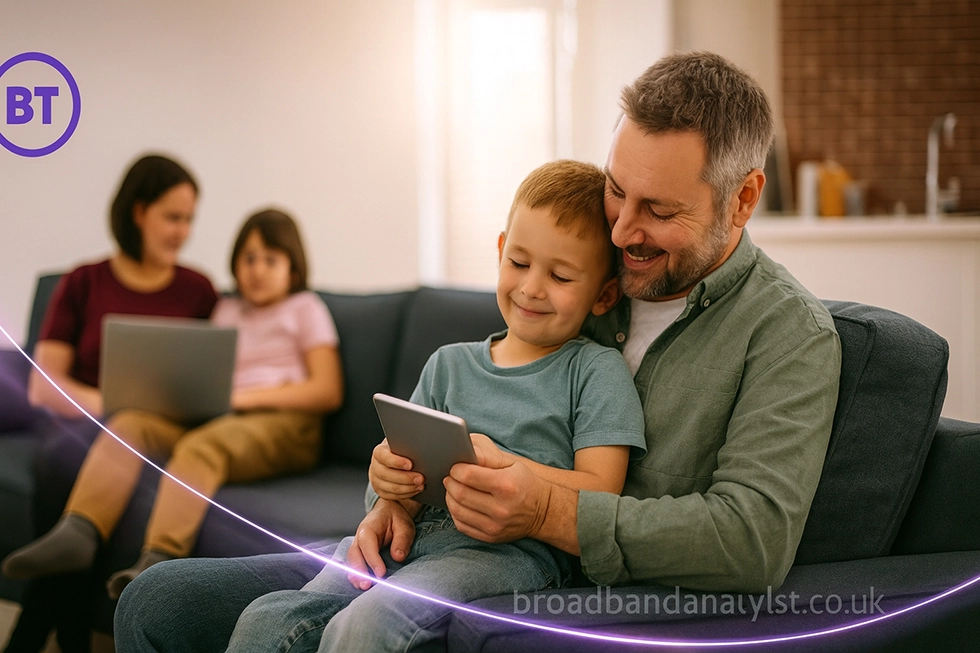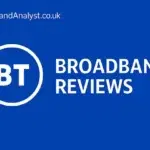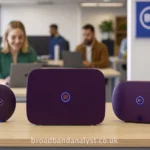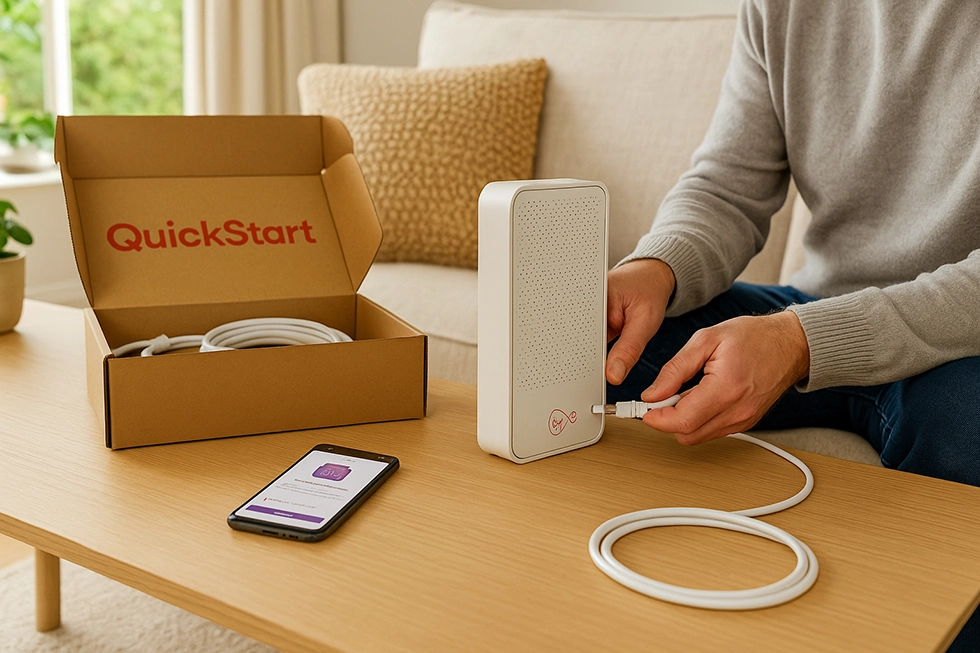BT Home Essentials Review – BT Social Tariff Plan
BT Home Essentials is a discounted broadband and phone option for people on certain UK benefits. It’s designed to keep core connectivity affordable, with a simple 12-month term and the freedom to cancel at any time without early exit fees.
If you already use BT, EE or Plusnet and you qualify, you can switch to Home Essentials at no extra charge.

Who can get Home Essentials
Eligibility for BT Home Essentials is linked to certain means-tested benefits. The scheme is designed for households on low or fixed incomes who might struggle with standard broadband prices. Both new and existing BT customers can apply, and if you’re already with EE or Plusnet, you can also switch across without paying extra.
To qualify, you must be receiving at least one of the following:
- Universal Credit (all claimants are eligible)
- Pension Credit (Guarantee Credit)
- Employment and Support Allowance
- Jobseeker’s Allowance
- Income Support
When you apply, you’ll need to provide your National Insurance number so BT can run a quick eligibility check. This is done to confirm that you are in receipt of one of the qualifying benefits.
There are also additional checks if you apply for the Home Essentials “No Income” plan, which is targeted at households with the lowest financial resources. This extra step helps BT make sure the right plan is being offered to the right customers.
For those already with BT, EE or Plusnet, switching to Home Essentials is straightforward. You keep your existing broadband line and services, but your billing is moved over to the Home Essentials rate. The transition is free of charge and there’s no need for a new contract installation unless your line type needs upgrading.
How to apply
You can apply for BT Home Essentials either online or by phone. During the application, you’ll be asked to confirm your eligibility, so it’s important to have your National Insurance number ready. This allows BT to check directly with the Department for Work and Pensions that you receive one of the qualifying benefits.
If you rely on telecare equipment, such as a personal alarm, or if you have any accessibility needs, you should also let BT know at the time of your application. BT runs a service called Here For You which is designed to give extra support to customers with health conditions, disabilities, or specific requirements. Registering means BT can set up the right options and make sure you have the right advice from the start.
Pros
- Clear eligibility rules with multiple plan options, including a No Income 36 Mbps plan and a low-cost call-only plan with unlimited minutes.
- Cancel any time with no early exit fees, which is flexible if your situation changes.
- Simple switching path for eligible BT, EE and Plusnet customers.
Things to consider
- If you’re no longer eligible at renewal, you will be moved to a standard package that follows BT’s fixed pounds-and-pence rise each March, or you can cancel instead. Budget for that change.
- TV add-ons still rise by £2 each March, and out-of-bundle charges increase by 5% each March.
- The 16 Mbps plan is only available where fibre isn’t, so availability depends on your address.
Speeds
Fibre Essentials delivers around 36 Mbps, while Fibre 2 offers average speeds of 67 Mbps. For households in areas where fibre is not available, BT also provides an unlimited broadband plan with an average speed of 16 Mbps.
A 36 Mbps connection is generally enough for everyday use, including web browsing, email, social media, online shopping, and streaming films or TV shows in HD. It can also handle a few video calls at the same time without too much trouble. The faster 67 Mbps tier is better suited to larger households where several people may be streaming or downloading content at once. It provides more headroom for online gaming, 4K streaming, and frequent large downloads such as software or game updates.
The 16 Mbps plan is an option for customers in areas that still do not have fibre coverage. While it will cover the basics, it can feel limited if more than one person is using the connection heavily.
Cost
BT Home Essentials offers a few different options depending on whether you need just a phone line or a full fibre broadband connection. All prices include VAT.
- Home Essentials Call-Only
£10 per month
Includes line rental and unlimited calls to UK landlines and mobiles. Best if you only need a home phone and no broadband. - Home Essentials Unlimited Broadband (16 Mbps)
£15 per month
Comes with line rental and unlimited calls. This plan is only available in areas where fibre broadband is not yet available. Average download speed is 16 Mbps. - Home Essentials Unlimited Fibre Essentials No Income (36 Mbps)
£16 per month
Includes line rental and unlimited calls, with average broadband speeds of 36 Mbps. This plan is aimed at households with no income. - Home Essentials Fibre Essentials (36 Mbps)
£21 per month
Broadband-only package with average speeds of 36 Mbps. Phone services can be added separately. - Home Essentials Fibre 2 (67 Mbps)
£24 per month
Broadband-only package with average speeds of 67 Mbps. Designed for homes with more users or heavier streaming and downloading needs.
If you choose one of the broadband-only packages but still want a landline, you can add a call plan:
- Pay As You Go calls: +£2 per month
- Unlimited Minutes: +£10 per month
Home Essentials covers both broadband and call options, with clearly published prices in BT’s Consumer Price Guide. These prices took effect on 2 May 2025.
BT Home Essentials packages are protected from the kind of fixed annual increases that apply to BT’s standard broadband plans. This means the core Home Essentials price itself does not rise each March by a set amount.
There are, however, two important exceptions to keep in mind. If you add a TV package, the TV part of your bill will increase by £2 each March. In addition, all out-of-bundle charges—such as extra calls outside your allowance or add-on services—go up by 5 percent each March.
Credit checks and payment options
If you are a new BT customer applying for Home Essentials, BT will carry out a standard credit check. In some cases, if your credit score is low, you may be asked to pay a refundable security deposit before your service can be activated. The exact amount of the deposit will be confirmed during your application, so you will know upfront before completing the order.
If you are already a BT customer and you are simply switching to Home Essentials, no new credit check is carried out. This makes the move straightforward and avoids delays in activation.
BT also offers several ways to pay your Home Essentials bill:
- Direct Debit (the most common method)
- Online using a debit or credit card
- By phone with a debit or credit card
- Bank transfer
- In person at a PayPoint outlet
Router and Wi-Fi
BT supplies its Smart Hub with Home Essentials broadband packages where a router is needed. The Smart Hub supports dual-band Wi-Fi (2.4 GHz and 5 GHz) using the 802.11ac Wi-Fi 5 standard. It is fitted with seven internal antennas and uses 3×3 MIMO on 2.4 GHz and 4×4 MIMO on 5 GHz to deliver better range and stability.
For wired connections, the hub includes four Gigabit Ethernet ports, and there is also a USB 2.0 port for connecting external storage or devices. The Smart Hub 2, which is the model most often supplied, also integrates Digital Voice support for landline calls over broadband.
Contract length and renewals
BT Home Essentials comes with a 12-month minimum term. Unlike standard broadband contracts, there are no early exit fees, so you can cancel at any time if your circumstances change. This flexibility is one of the main differences compared with BT’s standard packages.
As you approach the end of your first year, usually around month 11, BT will contact you to confirm whether you are still eligible. If you qualify, your plan will automatically roll over for another 12 months. At this point, you will be moved onto the latest version of the Home Essentials plan, and the price will adjust to whatever the current rate is for that package.
If you are no longer eligible, BT will instead move you to the closest equivalent standard broadband package at the lowest available price. Standard packages follow BT’s fixed pounds-and-pence annual price rise model each March. In this case, you don’t have to accept the change—you can either cancel without penalties or choose a different BT broadband plan that better suits your needs.
In short, you start with a 12-month agreement but you remain free to leave at any point, and each renewal comes with an eligibility check to make sure the plan still applies to you.
Who should choose Home Essentials
BT Home Essentials is aimed at households that qualify for a social tariff and need a lower-cost way to stay connected. The plans are built on BT’s fibre network and give the same average download speeds as BT’s standard Fibre Essentials and Fibre 2 packages, but at a discounted price.
The 36 Mbps plan is best suited to single users or small households. At this speed you can browse the web, check emails, stream HD video, and use video calls without issue. It can support two or three devices at once, but may feel stretched if several people are streaming or downloading at the same time.
The 67 Mbps plan is the more robust option for families or shared homes. With this tier there’s enough capacity for multiple HD or 4K streams, online gaming, and frequent large downloads such as operating system updates or console games. The higher bandwidth reduces slowdowns during peak hours, making it the safer choice for busier households.
If you only need a phone line, the Call-Only plan at £10 per month provides unlimited minutes to UK landlines and mobiles. It’s the lowest-cost option for those who don’t require broadband but want to keep a home phone for everyday use or emergency calls.
How does BT Home Essentials compare
| Plan | Speed | Contract | Price |
|---|---|---|---|
| BT Home Essentials Fibre 2 | 67 Mbps | 12 months | £24/m |
| BT Home Essentials Fibre Essentials | 36 Mbps | 12 months | £21/m |
| BT Home Essentials Fibre Essentials (No Income) | 36 Mbps | 12 months | £16/m |
| BT Home Essentials Unlimited Broadband | 16 Mbps | 12 months | £15/m |
| Community Fibre Essential 35 | 35 Mbps | 12 months | £12.50/m |
| Hyperoptic Fair Fibre 50 | 50 Mbps | 1-month | £15/m |
| Hyperoptic Fair Fibre 150 | 150 Mbps | 1-month | £20/m |
| Virgin Media Essential Broadband | 15 Mbps | 30-day rolling | £12.50/m |
| Virgin Media Essential Broadband Plus | 54 Mbps | 30-day rolling | £20/m |
| Vodafone Essentials (Fibre 2) | 73 Mbps | 12 months | £20/m |
| Sky Broadband Basics | 36 Mbps | 24 months | £20/m |
| NOW Broadband Basics | 36 Mbps | 1-month | £20/m |
| G.Network Essential Fibre (London) | 50 Mbps | 12 months | £15/m |
| KCOM Full Fibre Flex (Hull area) | 30 Mbps | 30-day rolling | £14.99/m |
| Fibrus Full Fibre Essential (NI & Cumbria) | 50 Mbps | 12 months | £14.99/m |
FAQ
Who can get Home Essentials and what proof do I need?
You can apply if you are a new or existing BT customer and receive one of these benefits: Universal Credit (all claimants), Pension Credit (Guarantee Credit), Employment and Support Allowance, Jobseeker’s Allowance, or Income Support. You’ll be asked for your National Insurance number so BT can verify eligibility. There are additional checks if you apply for the Home Essentials No Income plan.
I’m already with BT, EE or Plusnet. Can I switch to Home Essentials?
Yes. If you qualify, BT says existing BT, EE and Plusnet customers can move to Home Essentials at no extra charge. Your services and number typically stay the same, and your billing moves onto the Home Essentials price.
What speeds and plans are available?
Home Essentials has a few tiers. Fibre Essentials delivers around 36 Mbps, Fibre 2 delivers around 67 Mbps, and there is a 16 Mbps unlimited broadband plan used in addresses where fibre isn’t available. All plans include truly unlimited data. Choose 36 Mbps for light to moderate use; 67 Mbps suits busier homes with multiple streams, video calls and larger downloads.
What is the contract length and can I cancel early?
The minimum term is 12 months, but you can cancel at any time without early exit fees. That flexibility is part of the social-tariff design, so you’re not locked in if your circumstances change.
What happens after 12 months?
Around month 11, BT rechecks your eligibility. If you still qualify, your plan renews for another 12 months and you move to the latest equivalent Home Essentials package and price. If you no longer qualify, you’ll be switched to the latest equivalent standard package at the lowest available price, or you can cancel without early exit fees.
Do Home Essentials prices go up each March?
The Home Essentials package itself does not increase by a set pounds-and-pence amount each March. However, if you also take BT TV, the TV part goes up by £2 each March, and all out-of-bundle charges go up by 5 percent each March. Standard (non-Home Essentials) packages follow BT’s fixed pounds-and-pence annual rise model.
Can I add a home phone to a broadband-only plan?
Yes. If you choose a broadband-only Home Essentials tier, you can add a phone plan. Pay As You Go calling is typically available for a small monthly fee, or you can add Unlimited Minutes for a higher but still discounted monthly price. If you only need a landline and no broadband, there is also a call-only Home Essentials plan with unlimited UK landline and mobile minutes.
Will BT run a credit check?
If you are new to BT, a standard credit check applies and BT may ask for a refundable security deposit if your score is low. If you are already a BT customer and you are switching to Home Essentials, BT does not run a new credit check.
How do I pay my bill?
BT supports Direct Debit, online card payment, phone card payment, bank transfer and PayPoint. You can change payment method later in your My BT account if your situation changes.
What equipment do I get and how is the Wi-Fi?
BT supplies its Smart Hub with qualifying broadband plans where needed. For most small to medium homes it provides stable Wi-Fi coverage. Place the hub in a central, open spot, away from thick walls. In larger or multi-storey homes, consider adding mesh nodes if you notice weak rooms.
How does Digital Voice work and what about power cuts?
Calls are delivered over your broadband using BT’s Digital Voice service. Because it relies on your hub and mains power, your phone won’t work during a power cut unless you have backup power for the equipment. If you rely on telecare or have medical needs, tell BT so they can discuss battery backup and any additional support.
Can I manage call barring and other calling features?
Yes. Call Barring is included at no extra cost on Digital Voice for Home Essentials. You can turn it on or off and choose which call types to block from the My BT portal under the Digital Voice settings.
What if I become ineligible part-way through my term?
You can keep your plan to the end of the current 12-month period. At renewal, BT will run the eligibility check. If you no longer qualify, you’ll be moved to the latest equivalent standard package at the lowest available price, or you can cancel without early exit fees.
Is the 16 Mbps plan available everywhere?
No. The 16 Mbps unlimited broadband plan is only offered where fibre isn’t available at your address. If fibre is available, you’ll be offered one of the fibre tiers instead.
How do I apply and how long does activation take?
You can apply online or by phone. Have your National Insurance number ready for the eligibility check. Activation times vary by line type and whether an engineer visit is needed. BT will confirm your earliest go-live date during the order. If you’re already with BT, EE or Plusnet, the switch is usually an account change rather than a full reinstallation.
Can I combine Home Essentials with TV or mobile?
You can add BT TV if it’s available at your address, but remember the TV part has its own £2 March increase. You can also use BT or EE mobile alongside Home Essentials, but mobile plans and promotions are separate from the social-tariff discounts.





